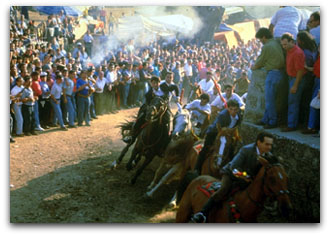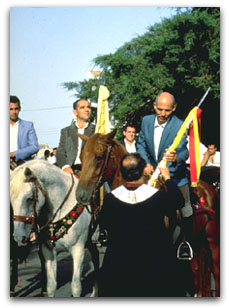On the 29th of June "sa prima
pandela" and the second and third flag bearers test the course and give the blank cartridges to
the riflemen who have been chosen by "sa prima pandela". Everything is now ready both for the
pagan and religious festival which is held in strict observance of the Catholic rite. On the 31st
August 1987, the Bishop of Alghero and Bosa, monsignor Giovanni Pes, recognised the church
of San Costantino as a Diocesan Sanctuary.
|
| Pope Johon Paul II said that in the
sanctuaries everyone has the joyful opportunity to immerse himself in prayer, not only in
liturgical prayer but also in those unspoilt kinds of popular piousness which often manifest the
religious spirit of the whole population which sometimes reaches an impressive theological
acumen combined with a superb poetic inspiration. For the church of San Costantino
this means the consecration of the church and in the opinion of the people this elevates the
importance of San Costantino. |
|
 |
The priests
of the neighbouring churches go to the church to help
welcome the faithful while scores of street traders display their goods.
The aroma of grilling sausages, roasting goats and roasting suckling pigs waft from the pilgrims
camp sites to fill the air.
|
 |
|
If you pass by them, they offer you
something to eat and a glass of Cannonau which is an excellent strong red wine that rinses the
mouth and warms the cockles of your heart. If you listen to them, you end up drinking "su filu e
ferru" a type of home made "moonshine or poteen", which is seldom less than 100% proof. This
is a good way to ensure 8 hours sleep without sleeping pills.
Everything is ready. It is the afternoon of the 6th of July. "Sa prima pandela", the most
important person, waits at home for his two assistants and his escort. They ride together as far
as the parish priest's house where about a hundred fearless impatient young horsemen are
gathered. The parish priest gives "Sa prima pandela" the yellow brocade standard of San
Costantino (called "Sa Pandela de Santu Antine in the local language). The second flag bearer
receives a white flag and the third flag bearer a red one.
|
|